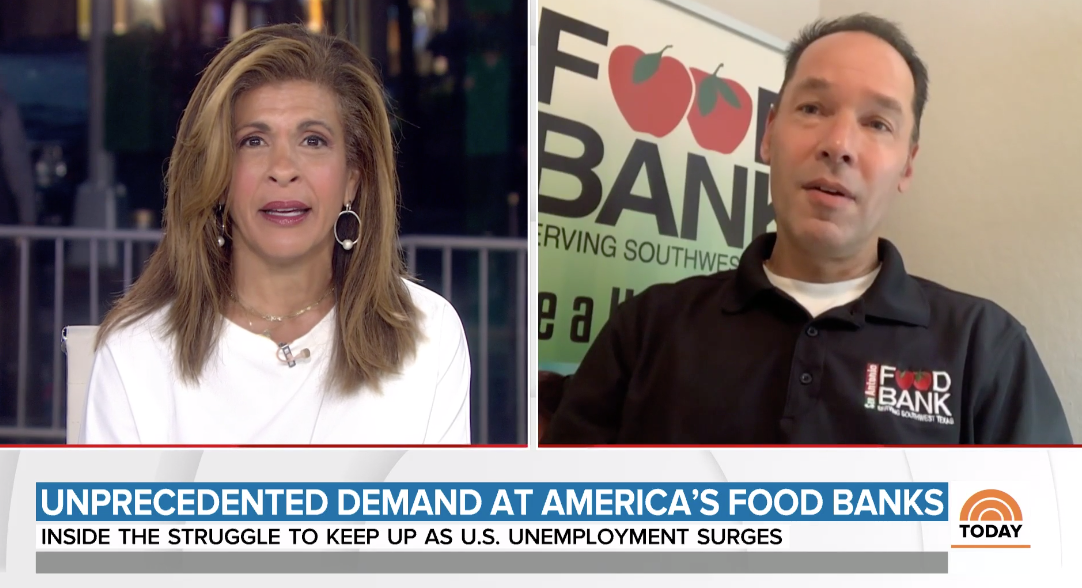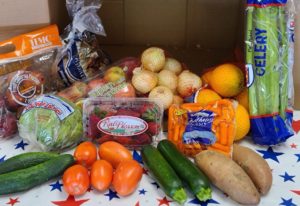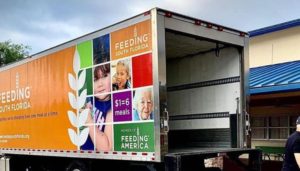Eric Cooper, CEO of San Antonio Food Bank, became the public face of the unprecedented need facing the nation’s food banks when he was interviewed this morning on NBC’s Today show, following an epic distribution that delivered a reported one million pounds of food to about 10,000 families last Thursday.
The distribution may have been the largest of a series of record-setting distributions happening with increasing regularity across the country. Images of miles-long lines of cars queuing up in places including San Diego, Pittsburgh and Michigan reflect the depth of the economic crisis playing out as a result of the coronavirus.
Six thousand families had pre-registered for San Antonio Food Bank’s April 9 distribution, and an additional 4,000 showed up, according to news reports. “We were so blown away and overwhelmed at the need in our community,” Cooper told the Today show.

That need is also reflected in a survey released Friday by Hunger Free America, which found that 38% of children are having to eat smaller meals or skip meals because of a lack of money in the household for food. The adult hunger rate is also higher, with 34% skipping meals or cutting portions.
Back in early March, San Antonio Food Bank had been on the leading edge of preparedness, undertaking a month-long initiative to prepare 300,000 kits containing 14-day supplies of non-perishable food and cleaning supplies. Those preparations were quickly consumed by demand, which now encompasses 120,000 people a week, up from 60,000 typically.
Such shocks to the system are increasingly becoming the norm. In a survey released last week, virtually all the food banks in Feeding America’s network (98%) said they are seeing increased demand for food. A doubling in demand is commonplace, reported by numerous organizations across the country, from Feeding Westchester in New York to Food Bank of Santa Barbara County in California.
Donated food, meanwhile, is slowing to a trickle as grocers strive to meet amped-up demand from consumers. Food banks typically rely heavily on donated food, but now are directly purchasing truckloads of food at an inconceivable pace: in April alone, the Capital Area Food Bank in Washington D.C. expects to purchase 45 truckloads of food, more than it purchased in all of last year.
The discounts that food banks normally receive for buying in bulk are no longer a possibility either, given the constrained supply chain. Food banks are competing on the open market for food, and at elevated prices. According to FMI, the food industry association, the price of pasta has increased by 229% from a year ago, and soup by 212%.
Unsurprisingly, 95% of food banks are reporting higher operational expenses, with 37% saying that they are facing an immediate, critical funding shortfall, according to Feeding America. A lack of volunteer help is exacerbating the situation, with 67% of food banks saying they are in need of volunteers, Feeding America said.
The plight of food banks has resulted in some high-profile donations. A $100 million gift to Feeding America from Amazon’s Jeff Bezos represents the single largest gift the non-profit has ever received. And a celebrity-driven GoFundMe account aims to raise $15 million.
Still, these efforts are not nearly enough to meet the nation’s need, which is expected to persist unabated until SNAP and unemployment benefits start to kick in. “It’s really going to take public-private partnerships,” Cooper told Today. “We hope federal and state governments lean in on this crisis.”
CAPTION ABOVE: A San Antonio Food Bank distribution served a reported 10,000 households last week.










